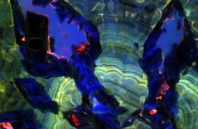A team of researchers at the Carl R. Woese Institute for Genomic Biology at the University of Illinois at Urbana-Champaign (U. of I.; Champaign, IL) has found through use of multiple types of microscopy that a kidney stone is built up in calcium-rich layers that resemble other mineralizations in nature. Key to their findings is that kidney stones partially dissolve and regrow again and again as they form.
This contradicts the widely held notion that kidney stones are homogenous rocks that never dissolve and are different from all other rocks in nature, explains University of Illinois geology and microbiology professor Bruce Fouke, who led the research with Jessica Saw, a medical student at the Mayo Clinic School of Medicine (Rochester, MN) and Ph.D. student at the U. of I.; and Mayandi Sivaguru, an associate director of the Carl Zeiss Laboratories at the Carl R. Woese Institute for Genomic Biology.
“Contrary to what doctors learn in their medical training, we found that kidney stones undergo a dynamic process of growing and dissolving, growing and dissolving,” Fouke says. “This means that one day we may be able to intervene to fully dissolve the stones right in the patient’s kidney, something most doctors today would say is impossible.

 (585) 768-2513
(585) 768-2513

